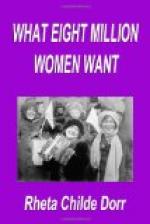But afterwards! The affair had been widely advertised, and it drew a throng of spectators, not only from every quarter of the city, but from every suburb and surrounding country town. Young men brought their sweethearts, their sisters, to see the “show.” As “Gypsy” Smith’s procession wound its noisy way out of the district, and back into the armory, this great mob of people surged into the streets pruriently eager to watch the awakening of the levee. It came. Lights flashed up in almost every house. The women appeared at the windows and even in the street. Saloon doors were flung open. The sound of pianos and phonographs rose above the clamor of the mob. Pandemonium broke loose as the crowds flung themselves into the saloons and other resorts. The police had to beat people back from the doors with their clubs. A riot, an orgy, impossible to describe, impossible to forget, ensued. Many of those who took part in it had never been in such a district before.
This horrible scene somehow typified to my mind the whole blind, chaotic, senseless attitude which society has preserved toward the most baffling of all its problems. Nothing done to prevent the evil, because no one knew what to do. After the evil was an established fact, after the hearts of the victims were thoroughly hardened, after the last hope of return had perished, then a “vice crusade”—led by a man!
Another scene witnessed about the same time seems to me to typify the new attitude which society—led by women—is assuming towards its problem. It was in the large kindergarten room of one of the oldest of Chicago’s social centers,—the Ely Bates Settlement. A group of little Italian girls, peasant clad in the red and green colors of their native land, swung around the room at a lively pace singing the familiar “Santa Lucia.” As the song ended the children suddenly broke into the maddest of dances, a tarantella. Led by a graceful young girl, one of the settlement workers, they danced with the joyous abandon of youthful spirits untrammeled, ending the dance with a chorus of happy laughter.
This was only one group of many hundreds in every quarter of Chicago,—in schools, settlements, kindergartens, and other centers,—who were rehearsing for the third of the annual play festivals given out of doors each year in Chicago. The festivals are held in the most spacious of the seventeen wonderful public gardens and playgrounds established of late throughout the city. Lasting all day, this annual carnival of play is shared by school children, working girls and boys, and young men and women. In the morning the children play and perform their costume dances. In the afternoon the fields are given up to athletic sports of older children, and in the evening young men and women, of all nationalities, many wearing their old-world peasant dresses, revive the plays and the dances of their native lands. Tens of thousands view the beautiful spectacle, which each year excites more interest and assumes an added importance in the civic life of Chicago.




